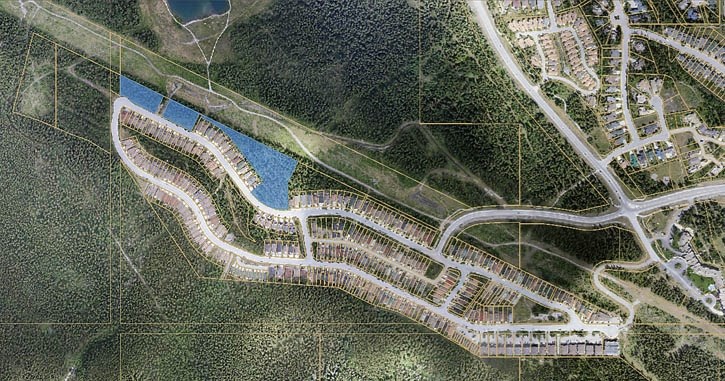CANMORE – A controversial development project in the Peaks of Grassi neighbourhood is one step closer to reality after Canmore’s subdivision authority gave its stamp of approval on July 2.
The plan is identical to the proposal presented to council earlier in May, when it narrowly voted in favour of rezoning the area for development.
Pierre Doyon, one of three proponents of the project, welcomed the decision.
“We are pleased with this decision,” wrote Doyon.
“It means more housing options for Canmore residents with four market town homes, eight duplexes with mortgage helper suites and 10 PAH (perpetual affordable housing) townhomes for CCHC (Canmore Community Housing Corporation).”
Under the approved plan, the two most western parcels of land will be subdivided into 10 residents lots.
Area one will be divided into two lots for townhomes and area two will be divided into eight duplex lots. Area three, which contains a rocky outcrop, will be transferred to municipal reserve and remain undeveloped.
Tracy Woitenko, a development planner for the Town, said administration supported the application because it meets the Town’s land use bylaw and municipal development plan.
She also provided a copy of nine other reports done for the project, including a steep creek hazard assessment, geotechnical survey and an environmental impact statement.
According to Woitenko, 92 letters were sent to adjacent neighbours to inform them of the subdivision application.
She said the Town received three letters in opposition, however none of them warranted any further changes to the application.
The approved plan is a dramatic change from what was originally proposed in January, which initially included a proposal to build 27 residential units with up to 13 accessory dwellings on three parcels of land on Lawrence Grassi Ridge. The original plan also included seven perpetual affordable housing units.
Those plans were changed on two separate occasions to try to satisfy public concerns heard during a public hearing in late January, as well as to accommodate a last minute amendment during second reading of the rezoning bylaw.
In the end, the developers agreed to scale back their plan and develop only two parcels of land. As a result, 68 per cent of the land is now dedicated as municipal reserve.
When the original proposal was presented to council in January, it was the third time the three parcels of land were the subject of a rezoning bylaw.
The proponents of the project first applied to rezone the area in 2014, but were denied by council because the plan only included two perpetually affordable housing units. There was also strong opposition to the development in the neighbourhood and throughout the community.
In 2015, the proponents applied again, but this time, the proposal included seven perpetually affordable housing units.
The application was approved by council in January 2016, but was strongly opposed by The Friends of Peaks of Grassi, a group that filed legal action against the landowners.
In the spring of 2016, the Court of Queen’s Bench granted an interim injunction concerning the development until full legal arguments for a judicial challenge against the rezoning bylaw could be heard.
Peaks resident and lawyer Mark Gruman filed the judicial review on several grounds that procedural fairness was breached, including the lack of an environmental impact statement (EIS) and third party review of the proposal.
In July 2018, Justice M. David Gates quashed the bylaw after concluding council breached its own rules when it approved the rezoning bylaw without conducting an EIS and third party review as outlined in Canmore’s old municipal development plan.
The proponents of the project reapplied in early January with a new application that included an EIS and third party review, and council approved the first reading of the bylaw on Jan. 8.
After a public hearing and several changes to the proposed plan, council voted 4-3 to pass third reading of the rezoning bylaw on May 7.




